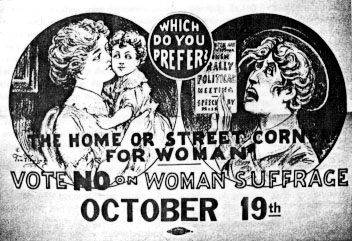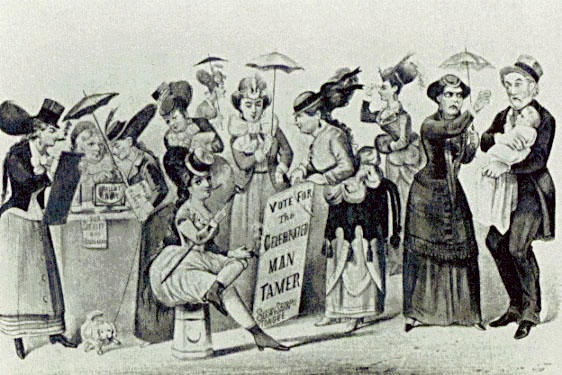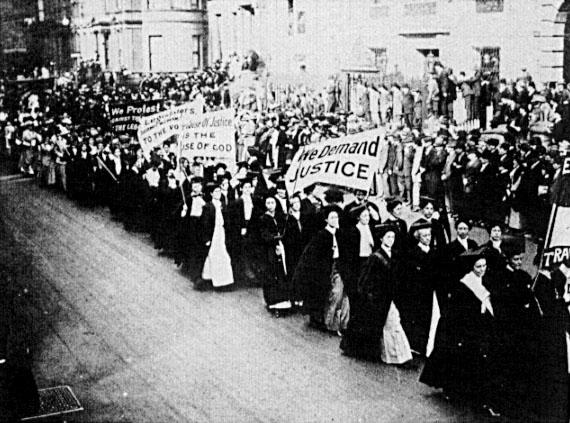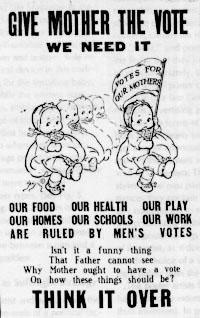

What follows is an annotated bibliography of American fiction published between 1870 and 1920 that deals with the woman suffrage movement. Some works use the "suffragette" figure to caricature the social and political excesses of the day; others are blatant propaganda for or against giving women the vote. All, however, encapsulate the major pro- and antisuffrage arguments of the period and provide insight into the debates over woman's nature and women's roles. For antisuffragists, women were inextricably connected (by God and nature) to the home, a haven from commercial and political life. Stereotypically "feminine" emotionalism over logic, in addition to physical delicacy, made women unfit for all the strenuous duties of full political participation. Domestic responsibilities, charitable work, and the exercise of indirect influence (through men) in the public arena occupied women sufficiently--the further burden of suffrage was unnecessary and unwanted. Furthermore, continued the antisuffrage argument, women who actively engaged in politics risked causing dissension in the home by arguing about political issues with their husbands, neglecting their children, and involving themselves with radical ideas such as socialism and free love. The foregoing is a rather crude exposition of some of the major reasons advanced for denying women the vote, but should give the reader some idea of the context in which the books below were written and some of the issues they sought to address. I have limited the selection of material to the 50-year span given above because this was the period of greatest public debate about woman suffrage, beginning with the notorious Victoria Woodhull's brief association with the movement and its split into two separate camps. Their reunion into the National American Woman Suffrage Association (NAWSA) in 1890 gave fresh impetus to the cause, which began to attract a large middle-class membership. Moreover, the "New Woman" of the 1890s had in effect achieved the goals outlined in the 1848 Declaration of Sentiments--all except gaining the vote on a national scale. During the 1910s, the younger generation of suffragists adopted the more radical British tactics of pickets, demonstrations, and parades, in addition to aligning with other Progressive-era reformers (such as Jane Addams) and organizing working-class women. During this period, too, both pro- and antisuffrage forces produced a large amount of graphic paraphernalia--posters, cartoons, banners, and even films--to convert the public to their respective stances. This material has been covered elsewhere (see "FURTHER READINGS" and "RELEVANT INTERNET SITES" below), but little has been written about the fiction generated by the woman suffrage movement in America. This bibliography attempts to fill that gap by providing both plot summaries and historical information as needed for each title.
Alcott, Louisa May. Jo's Boys, and How They Turned Out. A Sequel to "Little Men." Boston: Roberts Brothers, 1886.
Although a children's book, Jo's Boys intersperses its continuation of the March family chronicles with discussions of women's rights issues. Set at Plumfield, the seat of the coeducational Lawrence College, this episodic story permits characters to speak on temperance and moral purity, dress reform, "woman's sphere," and female education and careers. In one notable digression, tomboy Nan, matured into an efficient doctor, prods her grown-up male playmates into pledging support for woman suffrage. Yet Alcott also endorses the traditional wife and mother roles and promotes domestic skills as compatible with women's higher education and independence.
Bellamy, Charles. An Experiment in Marriage. Albany, New York: Albany Book Co., 1889.
Grape Valley's "practical socialism" in economic matters pales beside its doctrine of complete female equality, made possible by no-fault divorce, state-run childcare and housekeeping facilities, and women's full participation in the work force. The "right to free love" is this utopia's basis of social relations. After a two-year residence there, Henry Vinton returns briefly to New York and attends a radical meeting where woman suffrage advocates add to the general din. Their claims that female enfranchisement will guarantee the passage of good laws and a morally elevated public life merely cause Vinton and his associate Gillette to class them with the other charlatans proselytizing to gratify personal vanity. For Bellamy, women's emancipation is meant to allow the development of "womanly" qualities to the fullest, implicitly putting females at the sexual service of males.
Curtis, Isabel Gordon. The Congresswoman. Chicago: Browne & Howell Company, 1914.
Antisuffragists' assertions that women's political activities would ruin the home are demonstrated by Congresswoman Cynthia Pike's neglect of her eighteen-year-old son for her political duties, with near-disastrous results. A wealthy Oklahoma widow elected to Congress on the Suffrage ticket, Cynthia goes to Washington to become the only woman in the House of Representatives. Overwhelmed by the job's workload and social demands, and finding even chivalry insufficient to push her bills through Congress, she realizes woman's place is not in government and gladly relinquishes politics to capable and honest men. Her final Congressional speech calls for limited suffrage for both sexes to ensure that only an elite acting in the public interest will vote. Curtis faults the woman suffrage movement for extremism and attempting to blur distinctions between the sexes, and thus presents several suffragists as grotesque hermaphrodites to warn readers. The Amazonian lobbyist harassing Cynthia has not only shed most of her femininity, but her chaotic household undercuts her assertion that women can run the government as effectively as they do their homes.
De Forest, John. Playing the Mischief. New York: Harper & Brothers, 1875.
A political satire set in Washington, D.C., this book includes among its numerous characters "Squire" Nancy Appleyard, who asserts that by assuming masculine dress, she and other women will lead the way in seizing male privileges and replacing male tyranny with female rule. The shallowness of her beliefs is exposed when she falls desperately in love with crude, masterful Congressman Sykes Drummond; his refusal to wed after toying with her prompts a tearful promise to renounce her emancipation scheme, to no avail. De Forest based Squire Appleyard on the real-life suffragist, surgeon, spiritualist, and novelist Dr. Mary Walker, who often wore men's clothing in Washington society.

Deland, Margaret. The Rising Tide. New York: Harper & Brothers, 1916.
Frederica Payson, a wealthy and socially prominent young woman, believes in all the feminist positions and actively organizes for woman suffrage. Demonstrating her belief in equality, she proposes to the admiring Howard Maitland; shocked, he rejects her for her more conventional cousin Laura Childs. Fred's ostentatiously unconventional behavior--she smokes, swears, talks slang, and insists on working--culminates in her arrest for insulting a policeman while speaking at a strikers' rally. Stunned and disillusioned by Howard's wrath at her brief, but scandalous, imprisonment, Fred realizes that her feminist positions and provoking manner are too extreme and need modification. In the end she settles into a contented marriage with the older and wiser Arthur Weston, who grudgingly admits his agreement with the woman suffrage cause despite its excesses.
Gardener, Helen H. Pray You, Sir, Whose Daughter? Boston: Arena Publishing Co., 1892.
This novel graphically illustrates the necessity for female participation in government by centering on a proposal in New York state to lower the age of consent for girls to ten. The heroine's father is forced to admit that if respectable women were in the legislature, such a bill would inevitably fail. Elizabeth Cady Stanton comments in the preface that "the wrongs of society can be more deeply impressed on a large class of readers in the form of fiction than by essays, sermons, or the facts of science." Gardener apparently returned the favor by serving on the Revising Committee for Mrs. Stanton's 1895 Woman's Bible.
Garland, Hamlin. A Spoil of Office: A Story of the Modern West. Boston: Arena Publishing Co., 1892.
Beautiful, intelligent, and inspirational Ida Walker is both a Farmers' Alliance speaker and a suffragist. Captivated by one of her Grange picnic lectures, farm hand Bradley Talcott works his way through school and into a law practice before becoming a U.S. Senator--all to make himself worthy of her. He wins Ida, although the novel ends with their temporary separation as she returns West to lecture while he concludes his term in office. Ida's purity and directness contrasts favorably with young female office seekers' sexual maneuverings to gain jobs from state legislators, showing the superiority of women's direct political participation over their use of indirect influence.
Harrison, Mrs. Burton. A Bachelor Maid. New York: The Century Co., 1894.
Beautiful and wealthy Marion Irving, infected by the women's rights agitation spreading among her caste's members, breaks her engagement to upright rising lawyer Alec Gordon to pursue Causes. Her overbearing, selfish father's actions have taught her to see man as woman's oppressor, and her misguided interest in suffrage and other women's issues leads to an unfortunate friendship with "Madame" Sara Stauffer, her former college teacher. Although claiming to be an advanced thinker and advocate of Woman, Sara is actually an immoral fortune-hunter whose brief marriage to Marion's father for wealth and social position concludes in her abandoning him for a lecturing career. Marion barely escapes sacrificing herself to good works in a loveless marriage, finally realizing she loves Alec and that both sexes need to work together for women's emancipation. Mrs. Harrison's characters debate female suffrage to conclude that women as a class are not ready for the vote and that their unrest wrongly distracts them from fulfilling traditional female duties.
Haskell, Oreola Williams. Banner Bearers: Tales of the Suffrage Campaign. Geneva, New York: W. F. Humphrey, 1920.
As NAWSA historian Ida Husted Harper notes in the introduction, each of these twenty-two sketches portrays a facet of the many-sided efforts to win the vote, from organizing small-town suffrage leagues to visiting urban immigrants' tenement homes; from marching in suffrage parades to sharing committee work at Manhattan Borough meetings. Although allegedly fictionalizations of actual events, the stories are clearly propagandistic, depicting attractive, genteel suffrage workers as self-sacrificing and bent on promoting cross-class female unity. Haskell accurately depicts, however, Southern opposition to and Western support of the cause--the actual regional responses--and has her characters mouth the by-now standard pro- and antisuffrage arguments. Moreover, like the mainstream woman suffrage organizations and leaders, she takes the conservative middle ground on tactics by deploring militancy.

Herrick, Robert. One Woman's Life. New York: The Macmillan Co., 1913.
Social climber Milly Ridge, the "Grafter in petticoats," briefly takes up the women's rights movement when her husband's restrictions on her pocket money make her realize men's arbitrary and tyrannical nature. Her socialite friend Hazel Frederick shares both her modern views and her books on the woman question, although Milly just wants perfect love and cash. Hazel's suffrage work is the effective expression of all the advanced, radical ideas--settlement work, hygiene for the poor, and immigration agitation--for which she has always worked. She attempts to spread the Cause through Woman Forward Movement meetings in rich society women's drawing rooms across the Midwest; her disciples, however, are less a progressive vanguard than bored parasites robbed of their economic function. Working-class Ernestine Geyer scoffs at suffrage rhetoric, asserting that poorer women want money, not abstractions such as the vote, which cannot improve their social position. Hazel further reveals suffragists' class bias when she drops Milly for lacking ideas, ambition, and social sense precisely when the latter, newly widowed, sets up housekeeping with Ernestine.
James, Henry. The Bostonians. New York: Macmillan & Co., 1886.
This satirical "very American tale," possibly based on the real-life struggle between Susan B. Anthony and journalist Whitelaw Reid for the beautiful and gifted speaker Anna Dickinson, links feminism with the decaying New England reformist mindset, exemplified by the foolish, cause-ridden Miss Birdseye. Cultivated, yet drab and man-hating spinster Olive Chancellor loses her more traditionally feminine protégée Verena Tarrant to the dashing misogynist Southerner Basil Ransom. Although Basil "rescues" Verena by dragging her from the lecture platform, James intimates that their union will be considerably less than ideal. Other feminists include "the great apostle of the emancipation of women," temperance lecturer Mrs. Farrinder (who also has a "vague" husband in tow) and the masculinized professional Dr. Prance, who sports short hair and glasses. Both these women resemble the antisuffrage caricatures of feminist women that appeared frequently in the press during the 1870s.
Janvier, Thomas Allibone. The Women's Conquest of New York. New York: Harper & Brothers, 1894.
The subtitle says it all: "Being an account of the Rise and Progress of the Women's Rights Movement; of the Grant of Female Suffrage; of the Formation of the Area League; of the Capture by the Women Voters of the Government of the City of New York by the Election as Mayoress of Bridget O'Dowd; and of the Season of Female Despotism which thereafter ensued, and which was ended by an appeal to Primitive Natural Law." Chaos ensues as women gain political power; far from purifying government, they run an even more corrupt administration than the Tammany Hall bosses who helped them win the vote in the first place. Janvier's book, although intended to be humorous, explicitly reveals antisuffrage fears that giving women the vote will result in an increase in the "ignorant" immigrant vote and promote further governmental abuses.
Johnston, Mary. Hagar. Boston: Houghton Mifflin Co., 1913.
Writer Hagar Ashendyne escapes her prominent yet oppressive Virginia family to pursue artistic and personal growth in New York City. Her domineering yet conservative grandmother, "true womanly" yet foolish Aunt Serena, and rebellious yet sickly mother provide inadequate role models for the sensitive Hagar, who finds refuge among other professional women and in working for suffrage and socialism. However, by quietly enduring her family's intense disapproval and devoting nearly a decade to traveling with and caring for her selfish invalid father, Hagar displays a traditionally feminine nature as well. This New Woman eventually marries a New Man, engineer John Fay, who agrees to help her continue her work through marriage and motherhood. Johnston depicts the spread of woman suffrage and socialism as part of society's evolution towards a higher order, with Hagar and John Fay as its prototypical citizens. A founder of the Equal Suffrage League of Virginia in 1909, Mary Johnston explicitly wrote this novel as propaganda, producing what The Nation called "the Uncle Tom's Cabin of the suffrage movement."
Peattie, Elia W. The Precipice. Boston: Houghton Mifflin Co., 1914.
Kate Barrington resembles a New Woman heroine of the popular magazine fiction of the day: finding her post-college small-town life with a Victorian mother and tyrannical father stultifying, she moves to Chicago and becomes a social worker with the Children's Protective Association, a Hull House affiliate. Once there, she builds a circle of female friends, each representing a "type" of womanhood. Eventually, she quiets her nameless restlessness and discontent with Western mining entrepreneur Karl Wander, who agrees to accommodate their marriage to her career. Besides subscribing to Jane Addams's creed of "social housekeeping," Kate employs the expediency argument in insisting that women would use the ballot to further their benevolent activities. Although she marches in a suffrage parade and condones British militants' violent tactics, Kate (and Peattie) take the more conservative mainstream stance on women's rights.
Price, Hannah Julia. The Closed Door. Knoxville, Tennessee: Knoxville Lithographing Co., 1913.
Tomboy Mary Porter early indicates her unconventionality by protesting domestic work's thankless drudgery and seeking justice and liberty for herself. Her consciousness raised upon hearing a Women's Christian Temperance Union (WCTU) speaker on women's rights, she decides to devote herself to suffrage work. (The WCTU and NAWSA were in fact allies.) A potential romance with Philip Norman, who embodies the best qualities of the Old and New South, is aborted when his bargaining with a corrupt politician for the governor's office is exposed. Realizing that women must gain the vote if they are to clean up government and make their civic improvements last, Mary becomes an organizer for the newly-formed Tennessee Equal Suffrage Association. Struggling against indifference and overt hostility from both sexes, Mary slowly gains support from the "better class" and finds her work gives her reason to declare "I thank God I am a woman!" Price addresses her traditionally antisuffrage Southern audience by making her heroine a firm Democrat, a racist (Mary assures her servant that white women will be "equal to looking after the colored women" upon gaining the vote), and an advocate of meritocracy in government to battle corruption.
Shuler, Marjorie. For Rent--One Pedestal. New York: National Woman Suffrage Publishing Co., Inc., 1917.
This epistolary novel details Delight Dennison's work in the campaign to push a resolution endorsing woman suffrage through the state legislature. Fired from her teaching position for speaking at a street corner suffrage meeting, Delight becomes a full-time worker for the Cause, reversing her earlier "anti" stance. Campaign tactics include stump speaking in various neighborhoods, buttonholing local politicians for pledges of support, canvassing door-to-door, plastering posters on roadside barns, and organizing a massive parade. (A contemporary reviewer commented he had "a faint suspicion that the story is a disguised text-book.") Although city boss Big Tim Jordan's machinations defeat the resolution--and the reform candidate supporting it--on election day, Delight and her coworkers remain optimistic and begin organizing for their next campaign. Chatty, witty, and feminine, Delight not only asserts suffragists' domestic abilities through her public challenge for a baking contest with any "anti" (which nobody takes up), but converts and marries fellow reformer Bill Armstrong in the end.

Stowe, Harriet Beecher. My Wife and I; or, Harry Henderson's History. New York: J.B. Ford and Co. 1871.
Aspiring doctor Ida Van Arsdel, who seeks economic independence through greater vocational and educational opportunities, represents Stowe's moderate position on women's rights. Although she supports suffrage by arguing for the consent of the governed of both sexes in forming society's laws and institutions, Ida rejects the extremism of Audacia Dangyereyes (Victoria Woodhull) and Mrs. Cerulean (Isabella Beecher Hooker, prominent in the Connecticut suffrage movement). Audacia's scandalous behavior and radical sentiments offend propriety and threaten to promote anarchy, while Mrs. Cerulean's ignorance of practical public affairs and idealization of women's intuitive powers make her, despite her respectability, equally unfit for the vote. Stowe fiercely upholds the "true womanhood" ideal by rendering the acceptably progressive Ida as less traditionally feminine, giving her short hair, vitality rather than delicacy, and no pretension to beauty.
The Sturdy Oak: A composite novel of American Politics by fourteen American authors. New York: Henry Holt and Co., 1917.
A collaborative effort from writers including Fannie Hurst, Samuel Merwin, Alice Duer Miller, and Mary Austin (who also suggested the theme), the story follows rising politician George Remington's conversion to the woman suffrage cause from his earlier "anti" position. He comes to regret his metaphor for the ideal relationship of man the sturdy oak and woman the clinging vine when two "clinging vine" female relatives move in with him, his adoring wife becomes a suffragist, and he discovers the town's slum landlords are in fact wealthy, "helpless" women. The preface notes that this book was written for publication during the autumn Campaign of 1917 and that all profits are intended for the suffrage cause.
Whitlock, Brand. Her Infinite Variety. Indianapolis: The Bobbs-Merrill Company, 1914.
State Senator Morley Vernon's love for his old-fashioned, rather frivolous fiancee doesn't stop him from being charmed by lawyer Maria Burley Greene, who convinces him to promote a woman suffrage bill. Although this cause was previously crank Senator "Old Doc" Ames's province, Miss Greene's beauty and charm, further enhanced by her stereotypically feminine reluctance to speak publicly, convert Vernon. The most vigorous resistance comes from the women's clubs, whose delegation, led by Mrs. Overman Hodge-Lathrop, steamrolls into town with Vernon's fiancee Amelia in tow to squash the amendment. Although Mrs. Hodge-Lathrop insists that granting women the vote will drag them down from their exalted position and soil them with the muck of politics, she aggressively lobbies Senators and uses Amelia to distract Vernon, preventing him from delivering a timely speech to save the suffrage bill. Although "General" Hodge-Lathrop calls Miss Greene "that mannish thing, that female lawyer!" she of course is the unladylike one in both appearance and manner, which comments ironically on the inconsistencies of the antisuffragist stance.
Winslow, Helen M. A Woman For Mayor: A Novel of To-Day. Chicago: The Reilly & Britton Co., 1909.
"Say what you will, the woman was not meant for this kind of thing," explains Gertrude Van Deusen of her decision not to run for re-election as Roma's mayor. The attractive senator's daughter, elected on a platform dedicated to the eradication of political graft and corruption, must overcome two kidnapping attempts arranged by the leader of the corrupt board of aldermen before she can enact her reforms and declare her administration a success. Yet she abandons her political career to wed heroic reform politician John Allingham, who succeeds her as Roma's new mayor. Gertrude's public life has taught her to value the home as a place of refuge, making her a better wife and helpmeet. The novel's foreword articulates the prosuffrage argument that women's natural housekeeping abilities would ensure clean and well-run municipalities if women were put in charge. Moreover, journalist Winslow's involvement with the women's club movement is reflected in her depiction of the Progressive Workers' clubwomen as catalysts for "good government" reforms and wielders of considerable political clout.
Book Review Digest for reviews of selected titles.
Publishers' Weekly for advertisements and reviews of selected titles.
Bardes, Barbara and Suzanne Gossett. Declarations of Independence: Women and Political Power in Nineteenth-Century American Fiction. New Brunswick: Rutgers University Press, 1990.
Brownlow, Kevin. Behind the Mask of Innocence. New York: Knopf, 1990.
Camhi, Jane Jerome. Women Against Women: American Anti-Suffragism, 1880-1920. Brooklyn, New York: Carlson Publishers, 1994.
Friedl, Bettina, ed. On to Victory: Propaganda Plays of the Woman Suffrage Movement. Boston: Northeastern University Press, 1987.
Harper, Paula Hays. "A Graphic Episode in the Battle of the Sexes." In Henry Millon and Linda Nochlin, eds. Art and Architecture in the Service of Politics. Boston: MIT Press, 1978.
Kraditor, Aileen S. The Ideas of the Woman Suffrage Movement, 1890-1920. New York: W.W. Norton & Co., Inc., 1981.
Kraditor, Aileen S., ed. Up From the Pedestal: Selected Writings in the History of American Feminism. New York: Quadrangle/The New York Times Book Co., 1968.
Sheppard, Alice. Cartooning for Suffrage. Albuquerque: University of New Mexico Press, 1994.
Sloan, Kay. The Loud Silents: Origins of the Social Problem Film. Urbana: University of Illinois Press, 1988.
Wheeler, Marjorie Spruill, ed. Votes for Women! The Woman Suffrage Movement in Tennessee, the South, and the Nation. Knoxville: The University of Tennessee Press, 1995.
